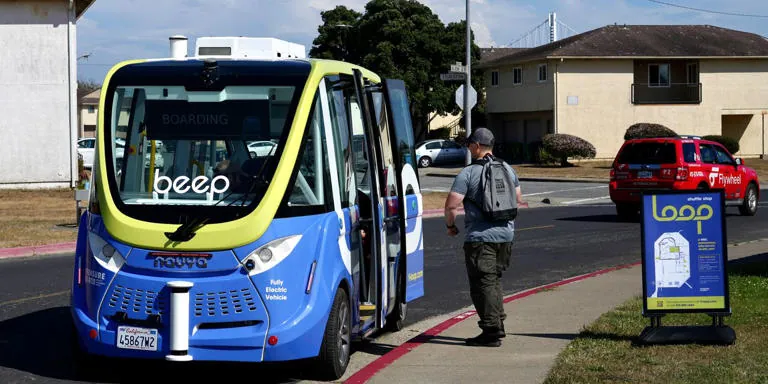In a significant leap forward, San Francisco introduces its latest innovation: driverless buses traversing the streets of Treasure Island.
San Francisco has successfully launched an autonomous shuttle service, marking another milestone after California’s regulatory approval of expanded robotaxi operations, despite initial concerns over traffic and safety.
The autonomous shuttle, operating on a daily basis, follows a designated route named the “Loop,” encircling Treasure Island—a once active U.S. Navy base nestled within San Francisco Bay. This fixed-route shuttle makes seven strategic stops, connecting local residential enclaves with shopping hubs and community centers, catering to the island’s 2,000 residents.
Running entirely on electric power, this cutting-edge vehicle lacks a traditional driver’s seat and steering wheel. However, the presence of an onboard attendant, capable of manually operating the bus with a handheld controller when needed, ensures a seamless journey. The implementation of this shuttle initiative is an integral component of a grant-supported pilot project, strategically devised to evaluate the potential synergy between autonomous vehicles and the preexisting public transportation infrastructure.
A passenger from Oakland shared, “Despite a few abrupt stops, my experience felt akin to riding any conventional bus.”
According to Tilly Chang, Executive Director of the San Francisco County Transportation Authority, the attendant’s presence ensures passenger comfort. She emphasized that this initiative is primarily a demonstration to understand the dynamics of integrating driverless shuttles within a controlled, low-traffic, and low-speed environment.
San Francisco stands as one among several global cities actively exploring the potential of self-driving vehicles to revolutionize public transportation. The autonomous shuttles on Treasure Island are operated by Beep, headquartered in Orlando, Florida, renowned for successfully implementing similar pilot programs across multiple U.S. locations, including prominent sites such as the Miami Zoo, Mayo Clinic, and Yellowstone National Park.
Shelley Caran, Beep’s project manager, emphasized that these shuttles are optimized for short, first-mile and last-mile routes, designed to supplement existing transportation options rather than replace them. Highlighting the advantages, Caran stated that autonomous vehicles boast quicker reaction times and more reliable service due to their immunity to distractions.
During a recent test ride, the autonomous shuttle demonstrated cautious and precise driving in autonomous mode, with an attendant manually maneuvering around obstacles when necessary. Passengers’ initial experiences were encouraging, with one rider affirming, “I felt secure throughout the ride, aside from a few abrupt stops that were manageable.”
Operating from 9 a.m. to 6 p.m. daily, the boxy shuttle accommodates up to 10 passengers and completes the Loop every 20 minutes. With a pair of shuttles available, passengers can expect consistent service as one recharges while the other transports passengers.
This pioneering autonomous shuttle project follows the California Public Utilities Commission’s decision to grant 24/7 passenger services to rival robotaxi companies, Cruise and Waymo, within San Francisco. This decision, despite some challenges related to unexpected stops and traffic disruptions, propelled the city to request a pause in the expansion of robotaxi operations.
Unlike robotaxis, experts anticipate fewer issues with autonomous buses due to their incorporation of drivers or attendants, at least for the foreseeable future. Nikolas Martelaro, an autonomous-vehicle researcher at Carnegie Mellon University, noted that trained operators remain essential as automation increases. He emphasized the importance of focusing not only on potential job implications but also on the required training for personnel.
While the advancement of autonomous-driving technology holds the promise of enhanced bus safety, the continued presence of drivers or attendants might negate one of the perceived benefits—reduced labor costs. Art Guzzetti, Vice President of the American Public Transportation Association, underscores the ongoing necessity of creating a viable market for these innovations, with the primary goal of enhancing efficiency and improving the travel experience, rather than displacing workers.
